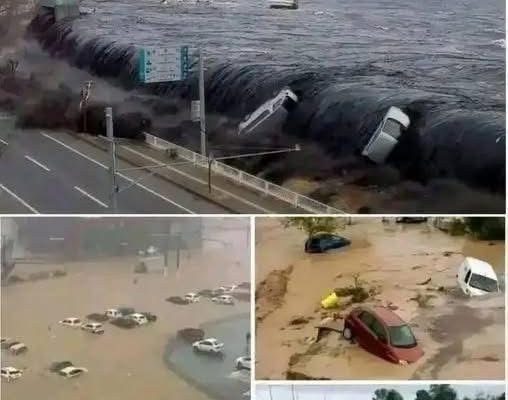At dawn on Tuesday, the world watched in disbelief as Japan was struck by one of the most powerful natural disasters in its modern history — a 9.1-magnitude earthquake followed by a massive tsunami that swept across the country’s northeastern coastline.
In just a few minutes, life across the nation changed forever. The quake, centered roughly 130 kilometers off Miyagi Prefecture, sent shockwaves that rippled through the earth’s crust, shaking buildings hundreds of kilometers away in Tokyo. Sirens blared, emergency alerts flashed across cellphones, and millions braced for impact.
The tremors lasted more than a minute — an eternity for anyone caught in them — and were strong enough to crack highways, tilt high-rises, and shut down power grids across several prefectures. Experts have already classified this as the most powerful seismic event to hit Japan in over a century, releasing an amount of energy rivaling the largest quakes ever recorded.
But the real catastrophe began minutes later, when ocean water pulled back unnaturally along the northeastern coast — the telltale sign of an incoming tsunami. Within twenty minutes, walls of water more than ten meters high slammed into the shoreline.
Entire towns vanished beneath surging waves. Fishing ports were flattened. Cars, homes, and ships were tossed inland like toys. The scenes broadcast live were almost beyond comprehension — a mix of chaos, destruction, and disbelief.
The Science Behind the Disaster
According to Japan’s Meteorological Agency (JMA), the quake originated in the Japan Trench, where the Pacific Plate subducts beneath the North American Plate — one of the most seismically active regions on Earth.
Dr. Hiroshi Tanaka, a senior seismologist at the University of Tokyo, explained, “The energy released was massive — comparable to hundreds of nuclear bombs. The shaking itself was catastrophic, but the real killer was the tsunami that followed.”
Japan’s advanced early warning systems gave residents 15 to 30 seconds of notice before the first waves hit — a testament to the country’s world-class disaster readiness. But even with that, the sheer scale of this event overwhelmed coastal defenses, including some of the reinforced seawalls built after the 2011 Tōhoku disaster.
The Immediate Aftermath
By midmorning, vast areas of the Tohoku and Hokkaido regions were submerged. Communication lines were down. Trains stopped on their tracks. Airports and expressways were closed. Millions of people were stranded without power or running water.
In Sendai, one of the hardest-hit cities, rescue teams waded through debris, searching for survivors trapped in submerged homes. Hospitals overflowed with the injured.
“Everything was gone in minutes,” said Keiko Arai, a 42-year-old teacher who managed to escape to higher ground with her two children. “I watched the water take our neighborhood — the school, our home, everything we owned. I don’t even know where to start again.”
Authorities have confirmed thousands of casualties, with the number expected to rise as search efforts continue. The Japanese Self-Defense Forces have deployed over 100,000 personnel for rescue operations, while the Prime Minister has declared a state of national emergency, mobilizing every available resource.
A Nation Mobilizes
From Tokyo to Okinawa, ordinary citizens are stepping up to help. Community centers have transformed into temporary shelters. Volunteers are distributing food, blankets, and medical supplies to displaced families.
In a televised address, Prime Minister Fumio Kishida vowed that Japan would endure:
“We have faced tragedy before, and we have risen every time. Japan’s strength is its people — their discipline, compassion, and unity. We will rebuild, and we will not break.”
The statement struck a chord with many who still carry memories of the 2011 disaster. Across the nation, social media flooded with hashtags like #StayStrongJapan and #TogetherForTohoku, as millions offered prayers and donations.
Global Response
The world has rallied to Japan’s side. Neighboring nations — including South Korea, China, and Australia — have dispatched search-and-rescue teams, while the United States has sent naval support to assist in humanitarian efforts.
UN Secretary-General António Guterres issued a statement praising Japan’s preparedness and urging global cooperation:
“What we are witnessing is a test of resilience not just for Japan, but for humanity’s ability to unite in times of crisis. Japan’s courage will remind us all of what solidarity truly means.”
Aid organizations such as the Red Cross and Médecins Sans Frontières have set up field hospitals in affected regions, while international relief flights carrying food, medicine, and portable generators continue to arrive at Tokyo’s Haneda Airport.
The Emotional Toll
The human cost, however, is immeasurable. In evacuation centers across Miyagi and Fukushima, survivors sit wrapped in blankets, staring at walls of missing-person notices. Parents hold photographs of children who have yet to be found.
“Every aftershock makes us relive it,” said Takumi Endo, a shopkeeper from Ishinomaki. “But every morning, we wake up and keep searching. Because we must.”
For many, this disaster has reopened old wounds from the 2011 Tōhoku quake and tsunami that killed nearly 20,000 people and triggered the Fukushima nuclear crisis. But it has also reignited that same unbreakable spirit of recovery that defined Japan then — a refusal to surrender to despair.
Infrastructure and Power Challenges
As engineers assess the damage, early reports indicate severe strain on the nation’s energy grid. Several nuclear power plants in the northeast have shut down automatically, though authorities insist there is no immediate radiation risk.
Major industrial hubs, including those in Sendai and Iwaki, have halted operations. Roads and rail networks remain crippled. Experts estimate it could take weeks to restore full transportation and utilities in the most affected zones.
Still, Japan’s resilience is already visible. Within hours, emergency response teams had restored partial power to hospitals and emergency shelters. Volunteer engineers worked through the night to reopen critical supply routes.
Stories of Survival
Amid the devastation, stories of heroism and survival continue to emerge. In one coastal town, a group of elementary school teachers successfully led all 68 students to safety by climbing to a nearby hill minutes before the tsunami struck.
In another, a fisherman who lost his boat returned to help rescue neighbors using nothing but a small wooden raft.
Such stories have become symbols of hope in a landscape defined by destruction — proof that even in the darkest hours, Japan’s collective strength endures.
Looking Ahead
As recovery begins, the challenges ahead are immense. Rebuilding homes, restoring livelihoods, and healing emotional scars will take years. Economists estimate damages could exceed $300 billion, making it one of the costliest natural disasters in world history.
Yet, as countless images show — volunteers clearing debris, children sharing blankets, rescue teams embracing survivors — Japan’s spirit remains unbroken.
In a nation built on fault lines, resilience is not a choice — it’s a way of life.
From the ashes of devastation, Japan will rise again, not just through technology or infrastructure, but through the enduring power of community, compassion, and resolve.
Seventeen hours after the earthquake, as aftershocks continued to rumble beneath the earth, thousands gathered quietly in the streets of Tokyo, holding candles for those lost.
The flickering lights stretched down entire blocks — small, trembling flames standing firm against the dark.
Just like Japan itself.



